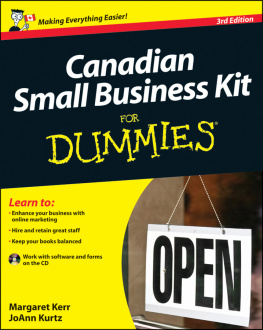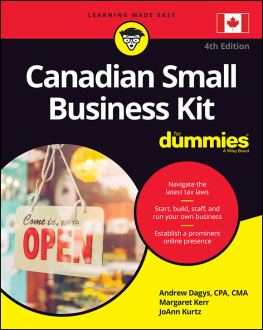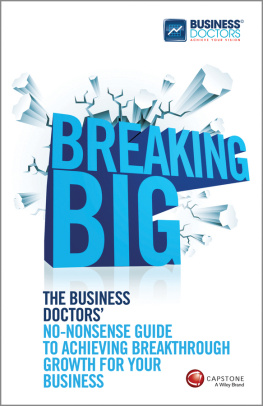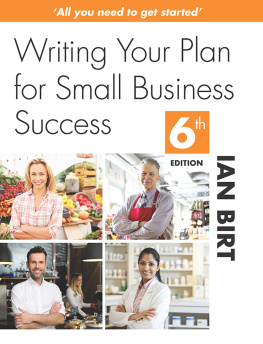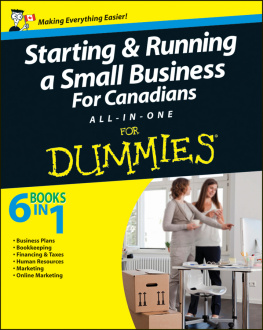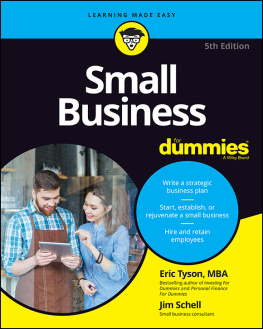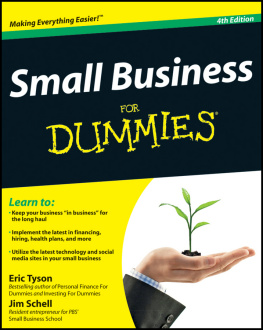Startup
Hacks
Hack 1
How to Create a Mission Statement
M any aspiring small business owners conflate defining a vision for their businesses and developing a mission statement. But those are two different, though important, elements of creating a solid foundation for your business.
Your companys vision, says Tim Berry, founder of Palo Alto Software, is essentially a future forecast. He advises entrepreneurs to Imagine what your company should be (its size, its business offerings, its customers, and so forth) three years from now. Thats your vision. Obviously as your business grows, your vision should evolve.
Your mission statement encapsulates your goals, philosophies, objectives and how you intend to serve your customers and employees. Who is a mission statement written for? You, to begin with. Just the act of creating it will help you clarify why youre in business. But its also vitally important for your employees to understand your companys mission and the part they play in it.
To come up with a mission statement that truly reflects your business, ask yourself some questions:
Why did you start/buy this business?
Who are your customers?
What do you stand for?
What perception do you want others to have of your company?
What are you selling?
What kind of work environment have you created?
What sets you apart from your competition?
While a mission statement should be shortno longer than three or so paragraphs, it should not be slapped together or created in haste. Take your time and get input from people you trust, whether they be members of your team, friends, family, your accountant or your lawyer. This is important, even if you are a solo entrepreneur. Were all familiar with the clich, Cant see the forest for the trees. That is a particularly apt expression for business owners who are so close to their ideas, its all too easy to overlook the obvious. Your mission statement will be better if you have someone challenge you on itand try to defend your assertions.
If youre stuck creating your mission statement, look at the ones other companies have created. (Dont copy; use these for inspiration.)
Once youre done make sure your employees understand your companys mission. If you like, you can post your mission statement in your store/office/restaurant/facility and on your website so your customers can see it.
Like business plans, mission statements shouldnt be written and forgotten. Periodically review your mission statement to make sure it still reflects your operating philosophy and, if it does, to ensure your actions support the mission. If youve outgrown your original mission, create a new one that signifies your new goals.
Hack 2
How to Define Your Unique Selling Proposition
E very small business needs to define, understand and live its unique selling proposition (USP). A USP is exactly what it sounds like, its what makes your business differentmakes it stand out from the crowd.
How can you best determine your USP?
1USPs are about benefits, not features. How does your business help your customers and clients? Whats the benefit to them of doing business with you? For instance, a green cleaning service reduces the risk of your customers families being exposed to allergens.
2The four Ps of marketing. Think about how the four Psproduct, price, placement (distribution channels) and promotional methods, and how they can help you define whats special about your small business. Do you sell hard-to-find products? Are your products organic? Is your service green? Do you donate a portion of profits to charity?
3Do you know why your customers do business with you? Understanding this will help you craft an effective USP. To find outask them. Conduct a survey or poll (this is easy and cheap to do online) or ask them in person. You can have an informal focus group, or just take some of your loyal customers out to lunch to get their insights. Monitor social media and ratings and review sites to see what people are saying online. Are your clients and customers looking to reaffirm their values, to get a good deal, to protect their loved ones, etc.?
4Be emotional. Once you discover why your customers buy from you, use that information and add some emotion to your USPit will help your audience connect to you and forge customer loyalty.
5What are your competitors USPs? If youre trying to stand out from the pack, you need to know how your competition defines themselves. You should always monitor your prime competition. Check their physical locations, website, social platforms and marketing messages to help you determine what they stand for and how you can differentiate your business. By definition, a USP that is shared by others is not unique. For instance, think about Dominos Pizza. Its USP was not that they delivered pizza. It was the guarantee that youd get your pizza in 30 minutes or less or youd get you money back. That USP was truly uniqueand helped create a multi-billion-dollar company.
Once you create your USP, you need to make sure your business lives it. Think of your USP as a promise youre making to your customersand nothing will drive business away faster than broken promises.
Dont make the mistake of thinking you only need to worry about your USP at startup. As your businessor the marketevolves, you should reassess your USP to make sure it still reflects your small business.
Hack 3
How to Brand Your Small Business
B uilding a brand is not the first thing entrepreneurs should do. Before you create a brand, you need to name your business, register your website, design a logo, develop your mission and vision statements and determine your USP. Only then can you start creating your brand.
Branding your business has nothing to do with marketing or advertising, although you will use marketing and advertising to build your brand. Your brand reflects the personality of your businessthe feeling you want to evoke in prospective customers when they think about your company. Is your brand homespun or sophisticated, all-American or exotic, cutting-edge or retro?
To define your brand, you might want to refer to your mission statement (Hack #1). You should be able to summarize what your brand stands for in one sentence. For example, Helping Hands is the in-home care service that provides seniors with friendly care, and their loved ones with peace of mind.
Its important to share your brand identity with your employees (if you have any) or contract workers, since theyre likely to be the ones conveying your brand message to customers.
Promoting a consistent visual identity is key to building your brand. Your visual identity stems from your logo, which should appear on all your marketing and advertising materials, from employee uniforms to your business cards and, of course, your business website, product packaging, signage and ads.
However, your visual identity goes far beyond your logo. Your marketing materialssuch as signage, uniforms or restaurant dcorshould use the same colors, style and graphics of your logo. Using consistent visual elements in all your marketing materials will condition customers to associate these elements with your brand.
Social media offers a whole new way to expand your brand. Create social media accounts for your brand, using your logo and any other visual elements that identify your brand. Then share and post content that reflects your brand identity. For example, if your brand is snarky and humorous, you might post funny memes or GIFsbut that wouldnt be appropriate for a home healthcare business, for example. For that type of business, sharing informational articles or resource links about senior care would make more sense. When in doubt, think back to the personality concept: when posting anything, consider whether it reflects your brands personality.
Next page

